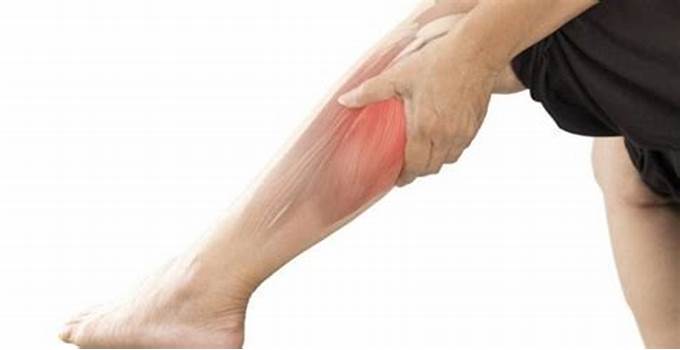Watch Video: Uncover the Top Causes of Calf Pain and How to Find Relief


Watch the video to learn about the top causes of calf pain and discover effective relief strategies.
Calf Pain: There can be many reasons for pain in the calves of the legs, such as muscle strain, nerve problems, or obstruction in blood circulation. Know the exact cause and treatment of this pain by consulting an expert doctor.
Calf pain is a common complaint that can significantly impact daily activities and overall quality of life. The calves, located at the back of the lower legs, are crucial for various functions, including walking, running, and standing. Pain in this area can result from a variety of causes, including muscle strain, nerve issues, and circulatory problems. Understanding the underlying cause of calf pain is essential for effective treatment and management. This comprehensive guide explores the common causes of calf pain, diagnostic approaches, and treatment options.
Common Causes of Calf Pain
Calf pain can arise from several different sources. Identifying the exact cause is critical for appropriate treatment. Below are some of the most common causes of calf pain:
1. Muscle Strain:
Muscle strain is one of the most frequent causes of calf pain. It occurs when the calf muscles are overstretched or torn, often due to sudden or intense physical activity.
- Symptoms: Sharp or aching pain in the calf, muscle stiffness, and difficulty moving the leg.
- Causes: Overexertion during exercise, improper warm-up, or sudden movements.
2. Cramps:
Calf cramps, or muscle cramps, are involuntary contractions of the calf muscles. They can be extremely painful and may occur during or after physical activity or even at rest.
- Symptoms: Sudden, intense pain and a hard, tight muscle that may feel like a knot.
- Causes: Dehydration, electrolyte imbalances, or prolonged periods of inactivity.
3. Nerve Problems:
Nerve issues can lead to calf pain by affecting the nerves that innervate the calf muscles. Conditions such as sciatica or peripheral neuropathy can cause pain radiating to the calves.
- Symptoms: Burning, tingling, or numbness in addition to pain in the calf.
- Causes: Herniated disc, spinal stenosis, or diabetic neuropathy.
4. Blood Circulation Issues:
Poor circulation can result in calf pain due to inadequate blood flow to the muscles. Conditions like deep vein thrombosis (DVT) and peripheral artery disease (PAD) are associated with calf pain.
- Symptoms: Swelling, warmth, redness, or pain in the calf; pain may worsen with activity and improve with rest.
- Causes: Blood clots, narrowed arteries, or chronic venous insufficiency.
5. Injuries and Trauma:
Injuries to the calf muscles or surrounding structures, such as fractures or sprains, can cause significant pain.
- Symptoms: Pain at the site of injury, swelling, bruising, and difficulty moving the leg.
- Causes: Direct trauma, falls, or accidents.
6. Tendonitis:
Tendonitis occurs when a tendon, such as the Achilles tendon, becomes inflamed. This condition can lead to calf pain and stiffness.
- Symptoms: Pain and tenderness along the Achilles tendon, particularly when moving the foot or walking.
- Causes: Overuse, repetitive stress, or sudden increases in physical activity.
7. Compartment Syndrome:
Compartment syndrome is a serious condition where pressure builds up within a muscle compartment, leading to pain and potential muscle damage.
- Symptoms: Severe pain, swelling, and tightness in the calf, especially after exercise.
- Causes: Trauma, prolonged pressure, or intense physical activity.
Diagnostic Approach to Calf Pain
Accurate diagnosis is essential for effective treatment. The diagnostic approach for calf pain typically involves the following steps:
1. Medical History:
A thorough medical history helps identify any underlying conditions or recent activities that could be related to calf pain.
- Questions: Duration and nature of the pain, recent physical activities, previous injuries, and any other symptoms like swelling or numbness.
2. Physical Examination:
A physical examination assesses the affected area for tenderness, swelling, and range of motion.
- Tests: The doctor may perform specific tests to evaluate muscle strength, flexibility, and the presence of any lumps or abnormalities.
3. Imaging Studies:
Imaging studies can provide detailed information about the structures of the calf and help identify any underlying issues.
- Ultrasound: Useful for detecting muscle tears, blood clots, or other soft tissue abnormalities.
- MRI: Provides detailed images of muscles, tendons, and nerves, useful for diagnosing tendonitis, compartment syndrome, or nerve problems.
- X-rays: May be used to rule out fractures or bone-related issues.
4. Blood Tests:
Blood tests can help identify conditions like diabetes, infections, or electrolyte imbalances that might contribute to calf pain.
- Tests: Complete blood count (CBC), electrolyte levels, and markers of inflammation.
5. Vascular Studies:
For suspected circulatory issues, vascular studies may be conducted to assess blood flow and identify any blockages or clots.
- Doppler Ultrasound: Evaluates blood flow in the veins and arteries.
Treatment Options for Calf Pain
Treatment for calf pain depends on the underlying cause. Here are common treatment approaches:
1. Rest and Ice:
For acute muscle strains or injuries, rest and ice can help reduce pain and swelling.
- Rest: Avoid activities that exacerbate the pain.
- Ice: Apply ice packs to the affected area for 15-20 minutes several times a day.
2. Compression and Elevation:
Compression and elevation can help manage swelling, especially in cases of injury or inflammation.
- Compression: Use an elastic bandage to apply gentle pressure.
- Elevation: Keep the affected leg elevated above heart level to reduce swelling.
3. Pain Relief Medications:
Over-the-counter (OTC) pain relievers can alleviate pain and reduce inflammation.
- Medications: Nonsteroidal anti-inflammatory drugs (NSAIDs) like ibuprofen or acetaminophen.
4. Physical Therapy:
Physical therapy can aid in the rehabilitation of muscle strains, tendonitis, and other musculoskeletal issues.
- Exercises: Stretching and strengthening exercises to improve flexibility and muscle strength.
- Manual Therapy: Techniques such as massage and joint mobilization.
5. Medical Interventions:
For more serious conditions, such as deep vein thrombosis or compartment syndrome, medical interventions may be required.
- Blood Clots: Anticoagulants or thrombolytics to dissolve clots.
- Compartment Syndrome: Surgery may be necessary to relieve pressure.
6. Lifestyle Modifications:
Making certain lifestyle changes can help prevent and manage calf pain.
- Hydration: Ensure adequate fluid intake to prevent cramps.
- Exercise: Engage in regular, moderate exercise to maintain muscle strength and flexibility.
- Footwear: Wear appropriate, supportive shoes to reduce strain on the calves.
7. Surgery:
In rare cases, surgery may be needed to address underlying issues, such as severe tendon injuries or structural abnormalities.
- Procedures: Tendon repair, fasciotomy for compartment syndrome, or surgical interventions for nerve compression.
Preventive Measures for Calf Pain
Preventing calf pain involves taking steps to reduce the risk of injury and maintain overall leg health:
1. Warm-Up and Stretching:
Proper warm-up and stretching before physical activity can help prevent muscle strains and cramps.
- Warm-Up: Engage in light aerobic activity to increase blood flow to the muscles.
- Stretching: Perform dynamic stretches targeting the calf muscles.
2. Gradual Increase in Activity:
Avoid sudden increases in the intensity or duration of physical activity. Gradually increase exercise levels to allow the muscles to adapt.
3. Adequate Hydration and Nutrition:
Maintain proper hydration and a balanced diet to support muscle function and prevent cramps.
- Electrolytes: Ensure adequate intake of potassium, magnesium, and calcium.
4. Proper Footwear:
Wear well-fitting, supportive shoes to reduce strain on the calves during physical activities.
5. Regular Exercise:
Incorporate strength training and flexibility exercises into your routine to keep the calf muscles strong and adaptable.
Calf pain, while common, can stem from a variety of causes, each requiring a tailored approach for diagnosis and treatment. Whether the pain results from muscle strain, nerve issues, or circulatory problems, understanding the underlying cause is crucial for effective management.
By consulting a healthcare professional, individuals can receive a proper diagnosis and develop a comprehensive treatment plan that addresses their specific needs. Implementing preventive measures and making lifestyle adjustments can also help manage and reduce the risk of calf pain.
As we navigate the complexities of calf pain, it is important to remain informed and proactive. With the right approach, most individuals can find relief and return to their normal activities with minimal disruption.
Recent Posts
Holi and Eye Safety: Protect Your Vision During Festivities
Holi, the festival of colors, is one of the most vibrant and joyous celebrations in…
FDA Recalls Popular Skincare Products Over Cancer-Causing Chemical
In a major development, the U.S. Food and Drug Administration (FDA) has issued recalls for…
Kidney Transplant Crisis: Why 98% of Patients in Delhi Die Waiting
In Delhi, the struggle for kidney transplant patients is a dire one. Less than 2%…
Diabetes & Eye Health: Why Regular Screening Matters
Diabetes is a chronic condition that affects millions of people worldwide. It occurs when the…
What Happens to Your Body in the First 72 Hours After Quitting Smoking?
Quitting smoking is one of the most significant steps you can take to improve your…
Deadly Flu Outbreak in Delhi-NCR: Hospitals Overwhelmed
As the warmer months set in, Delhi-NCR is witnessing an alarming surge in flu cases,…



